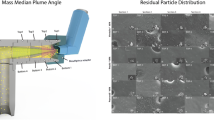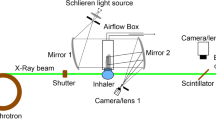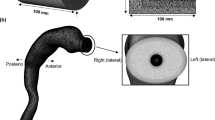Abstract
The aim of this study is to investigate aerosol plume geometries of pressurised metered dose inhalers (pMDIs) using a high-speed laser image system with different actuator nozzle materials and designs. Actuators made from aluminium, PET and PTFE were manufactured with four different nozzle designs: cone, flat, curved cone and curved flat. Plume angles and spans generated using the designed actuator nozzles with four solution-based pMDI formulations were imaged using Oxford Lasers EnVision system and analysed using EnVision Patternate software. Reduced plume angles for all actuator materials and nozzle designs were observed with pMDI formulations containing drug with high co-solvent concentration (ethanol) due to the reduced vapour pressure. Significantly higher plume angles were observed with the PTFE flat nozzle across all formulations, which could be a result of the nozzle geometry and material’s hydrophobicity. The plume geometry of pMDI aerosols can be influenced by the vapour pressure of the formulation, nozzle geometries and actuator material physiochemical properties.










Similar content being viewed by others
References
Thiel C. From Susie’s question to CFC free: an inventor’s perspective on forty years of MDI development and regulation. Respir Drug Deliv. 1996;1:115–24.
Bell J, Newman S. The rejuvenated pressurised metered dose inhaler. Expert Opin Drug Deliv. 2007;4(3):215–34.
Newman SP. Principles of metered-dose inhaler design. Respir Care. 2005;50(9):1177–90.
Kim CS, Eldridge MA, Sackner MA. Oropharyngeal deposition and delivery aspects of metered-dose inhaler aerosols. Am Rev Respir Dis. 1987;135(1):157–64.
Sunita L. An overview on: pharmaceutical aerosols. International Research Journal of Pharmacy. 2012;3(9):68–75
FDA. Guidance for Industrv Metered Dose Inhaler (MDI) and Dry Powder Inhaler (DPI) Drug Products. Center for Drug Evaluation and Research (CDER). 1998; http://www.fda.gov/ohrms/dockets/ac/00/backgrd/3634b1c_sectiond.pdf.
Hünerbein B, Kala H, Moldenhauer H. Aerosols and sprays. Pharmazie. 1978;33(12):824–31.
Benjamin EJ, Kroeten JJ, Shek E. Characterization of spray patterns of inhalation aerosols using thin‐layer chromatography. J Pharm Sci. 1983;72(4):380–5.
Smyth H, Hickey A, Brace G, Barbour T, Gallion J, Grove J. Spray pattern analysis for metered dose inhalers I: orifice size, particle size, and droplet motion correlations. Drug Dev Ind Pharm. 2006;32(9):1033–41.
Crosland BM, Johnson MR, Matida EA. Characterization of the spray velocities from a pressurized metered-dose inhaler. J Aerosol Med Pulm Drug Deliv. 2009;22(2):85–98.
Oliveira RF, Teixeira S, Teixeira JC, Silva LF, Antunes H. pMDI sprays: theory, experiment and numerical simulation. In Book: Advances in Modeling of Fluid Dynamics. Intech. 2012;11:255-92. doi:10.5772/46099.
Kakade PP, Versteeg HK, Hargrave GK, Genova P, Williams Iii RC, Deaton D. Design optimization of a novel pMDI actuator for systemic drug delivery. J Aerosol Med. 2007;20(4):460–74.
Naqwi AA, Durst F. Light scattering applied to LDA and PDA measurements. Part 1: theory and numerical treatments. Part Part Syst Charact. 1991;8(1–4):245–58.
Naqwi AA, Durst F. Light scattering applied to LDA and PDA measurements Part 2: computational results and their discussion. Part Part Syst Charact. 1992;9(1–4):66–80.
Bodoc V, Laurent C, Biscos Y, Lavergne G. Advanced measurement techniques for spray investigations. AerospaceLab. 2009;1(1):1–16.
Tuck C, Ellis M, Miller P. Techniques for measurement of droplet size and velocity distributions in agricultural sprays. Crop Prot. 1997;16(7):619–28.
Johal B, Murphy S, Marshall J. Plume characteristics of fluticasone propionate/formoterol pMDI compared with fluticasone propionate/salmeterol pMDI. Eur Respir J. 2013;42 Suppl 57:4132.
Miller PC, Tuck CR, Murphy S, da Costa Ferreira M, editors. Measurements of the droplet velocities in sprays produced by different designs of agricultural spray nozzle. European Conference on Liquid Atomization and Spray Systems, Como Lake, Italy; 2008.
Kwok PCL, Chan HK. Electrostatics of pharmaceutical inhalation aerosols. J Pharm Pharmacol. 2009;61(12):1587–99.
Chen Y, Young PM, Fletcher DF, Chan HK, Long E, Lewis D, et al. The influence of actuator materials and nozzle designs on electrostatic charge of Pressurised Metered Dose Inhaler (pMDI) formulations. Pharm Res. 2014;31(5):1325–37.
Chen Y, Young P, Fletcher D, Chan HK, Long E, Lewis D, et al. The effect of actuator nozzle designs on the electrostatic charge generated in pressurised metered dose inhaler aerosols. Pharm Res. 2014;31(5):1325–37.
Diaz AF, Felix-Navarro RM. A semi-quantitative tribo-electric series for polymeric materials: the influence of chemical structure and properties. J Electrost. 2004;62(4):277–90.
Vervaet C, Byron PR. Drug–surfactant–propellant interactions in HFA-formulations. Int J Pharm. 1999;186(1):13–30.
Lefebvre A. Atomization and sprays CRC press; 1988;1040(2756):155–97.
Sou A, Hosokawa S, Tomiyama A. Effects of cavitation in a nozzle on liquid jet atomization. Int J Heat Mass Transf. 2007;50(17):3575–82.
Tamaki N, editor. Effects of cavitation in a nozzle hole on atomization of spray and development of high-efficiency atomization enhancement nozzle. Proceedings the 11th international conference on liquid atomization and spray systems, paper; 2009.
Brambilla G, Ganderton D, Garzia R, Lewis D, Meakin B, Ventura P. Modulation of aerosol clouds produced by pressurised inhalation aerosols. Int J Pharm. 1999;186(1):53–61.
Acknowledgments
This research was supported by the Australian Research Council Linkage Project funding scheme (project number ARC-LP100200156) and Chiesi Ltd, Chippenham, Wiltshire, UK. Professor Traini is the recipient of an Australian Research Council Future Fellowship (project number FT12010063). Professor Young is the recipient of an Australian Research Council Future Fellowship (project number FT110100996).
Author information
Authors and Affiliations
Corresponding author
Rights and permissions
About this article
Cite this article
Chen, Y., Young, P.M., Murphy, S. et al. High-Speed Laser Image Analysis of Plume Angles for Pressurised Metered Dose Inhalers: The Effect of Nozzle Geometry. AAPS PharmSciTech 18, 782–789 (2017). https://doi.org/10.1208/s12249-016-0564-5
Received:
Accepted:
Published:
Issue Date:
DOI: https://doi.org/10.1208/s12249-016-0564-5




